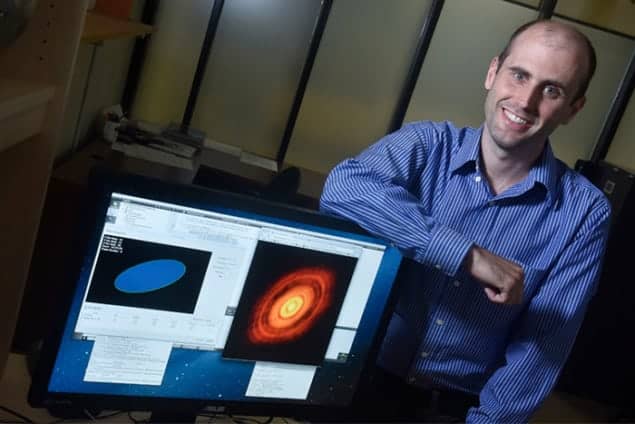
A system of seven rocky exoplanets – recently found to be orbiting the same star – avoid colliding with each because their orbits are highly synchronized, according to computer simulations done by astrophysicists in Canada.
The TRAPPIST-1 system, which astronomers announced in February that they had discovered, is the largest known system of Earth-like exoplanets. Three of the planets appear to be in the habitable zone of the star, which means that they could harbour liquid water and possibly even life.
Since its discovery, however, astronomers have puzzled over how TRAPPIST-1 remains stable. “If you simulate the system, the planets start crashing into one another in less than a million years,” says Dan Tamayo, who works at the University of Toronto’s Centre for Planetary Science. One possibility is that astronomers have been incredibly lucky to see the system before it falls apart – but Tamayo was convinced that there must be a reason why TRAPPIST-1 is stable.
Resonant chain
He therefore joined forces with Matt Russo, Andrew Santaguida and others at Toronto, who began by looking at the sequence of the ratios of the orbital periods of adjacent exoplanets in the system. Astronomers know that this sequence is a “resonant chain”, which means that all of the orbits are synchronized with each other. The exoplanets therefore undergo a highly choreographed and repetitive dance as they travel around the star – and never collide with each other.
“Most planetary systems are like bands of amateur musicians playing their parts at different speeds,” says Russo. “TRAPPIST-1 is different. It’s a super-group with all seven members synchronizing their parts in nearly perfect time.”
The problem, however, is that for such a resonant chain to remain stable for a very long time, the seven orbits must be perfectly aligned. And because astronomers cannot currently measure this alignment to high precision, computer simulations that incorporate this uncertainty suggested that TRAPPIST-1 is unstable.
Supercomputing cluster
Tamayo and colleagues have taken a different approach by looking at how the system formed from a disc of gas and dust and evolved towards its current configuration. Using a supercomputing cluster at the Canadian Institute for Theoretical Astrophysics, the team did a number of simulations that traced the formation and evolution of TRAPPIST-1. In most cases, the system that formed was found to remain stable over a period of 50 million years, which is the longest period of time they were able to simulate.
The team believes that the exoplanets settled naturally into the stable resonant condition during the formation process. “This means that early on, each planet’s orbit was tuned to make it harmonious with its neighbours, in the same way that instruments are tuned by a band before it begins to play,” says Russo.
The simulations are described in The Astrophysical Journal Letters.



